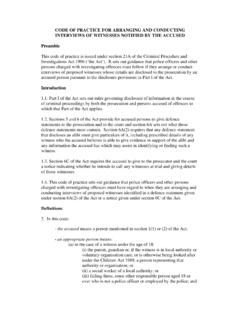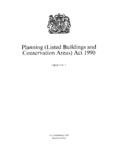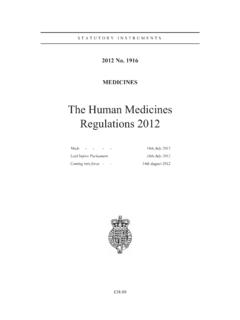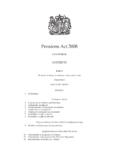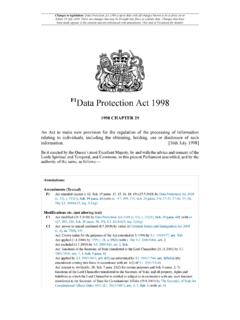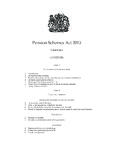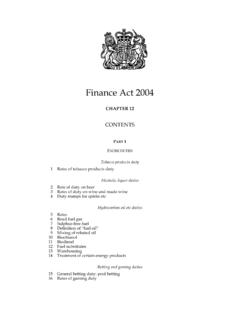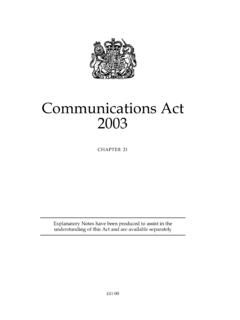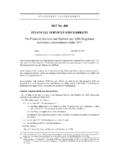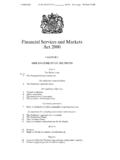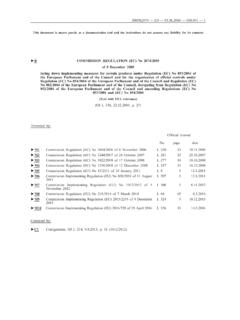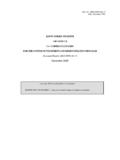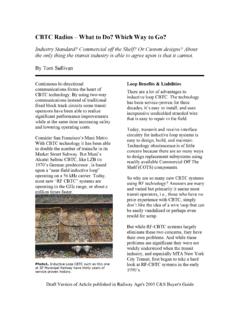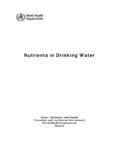Transcription of 2005 No. 1093 HEALTH AND SAFETY - Legislation.gov.uk
1 STATUTORY INSTRUMENTS 2005 No. 1093 health and safety The Control of Vibration at Work Regulations 2005 Made - - - - 4th April 2005 Laid before Parliament 7th April 2005 Coming into force - - 6th July 2005 ARRANGEMENT OF REGULATIONS and and transitional limit values and action of the risk to HEALTH created by vibration at the or control of exposure to vibration at the , instruction and certificates for emergency certificates for air relating to the Ministry of outside Great Secretary of State, in the exercise of the powers conferred on him by sections 15(1), (2) and (5), and 82(3) of, and paragraphs 1(1)(a) and (c), 8(1), 9, 11, 13(2) and (3), 14, 15(1), 16 and 20 of Schedule 3 to, the HEALTH and SAFETY at Work etc.
2 Act 1974(a) ( the 1974 Act ) and of all other powers enabling him in that behalf, for the purpose of giving effect without modifications to proposals submitted to him by the HEALTH and SAFETY Commission under section 11(2)(d) of the 1974 Act after the carrying out by the said Commission of consultations in accordance with section 50(3) of that Act, hereby makes the following Regulations: Citation and commencement 1. These Regulations may be cited as the Control of Vibration at Work Regulations 2005 and shall come into force on 6th July 2005 . (a) 1974 ; sections 11(2), 15(1) and 50(3) were amended by the Employment Protection Act 1975 , Schedule 15, paragraphs 4, 6 and 16(3) respectively.
3 2 Interpretation2. (1) In these Regulations daily exposure means the quantity of mechanical vibration to which a worker is exposed during a working day, normalised to an 8-hour reference period, which takes account of the magnitude and duration of the vibration; emergency services include (a) police, fire, rescue and ambulance services; (b) Her Majesty s Coastguard; enforcing authority means the Executive or local authority, determined in accordance with the provisions of the HEALTH and SAFETY (Enforcing Authority) Regulations 1998(a); exposure action value means the level of daily exposure set out in regulation 4 for any worker which, if reached or exceeded, requires specified action to be taken to reduce risk; exposure limit value means the level of daily exposure set out in regulation 4 for any worker which must not be exceeded, save as set out in regulation 6(5); the Executive means the HEALTH and SAFETY Executive; hand-arm vibration means mechanical vibration which is transmitted into the hands and arms during a work activity; HEALTH surveillance means assessment of the state of HEALTH of an employee, as related to exposure to vibration.
4 Mechanical vibration means vibration occurring in a piece of machinery or equipment or in a vehicle as a result of its operation; risk assessment means the assessment of risk required by regulation 5; whole-body vibration means mechanical vibration which is transmitted into the body, when seated or standing, through the supporting surface, during a work activity or as described in regulation 5(3)(f); and working day means a daily working period, irrespective of the time of day when it begins or ends, and of whether it begins or ends on the same calendar day. (2) In these Regulations, a reference to an employee being exposed to vibration is a reference to the exposure of that employee to mechanical vibration arising out of or in connection with his work.
5 Application and transitional provisions 3. (1) These Regulations shall have effect with a view to protecting persons against risk to their HEALTH and SAFETY arising from exposure to vibration at work. (2) Subject to paragraph (3), regulation 6(4) shall not apply until 6th July 2010 where work equipment is used which (a) was first provided to employees prior to 6th July 2007 by any employer; and (b) does not permit compliance with the exposure limit values, but in using such equipment the employer shall take into account the latest technical advances and the organisational measures taken in accordance with regulation 6(2). (3) For the agriculture and forestry sectors, regulation 6(4) shall not apply to whole-body vibration until 6th July 2014 in respect of work equipment which (a) was first provided to employees prior to 6th July 2007 by any employer; and (b) does not permit compliance with the exposure limit value for whole-body vibration, (a) 1998/494, as amended by 1999/2024, , 2002/2675, and 2004/3168.
6 3but in using such equipment the employer shall take into account the latest technical advances and the organisational measures taken in accordance with regulation 6(2). (4) Where a duty is placed by these Regulations on an employer in respect of his employees, he shall, so far as is reasonably practicable, be under a like duty in respect of any other person, whether at work or not, who may be affected by the work carried out by the employer except that the duties of the employer (a) under regulation 7 ( HEALTH surveillance) shall not extend to persons who are not his employees; and (b) under regulation 8 (information, instruction and training) shall not extend to persons who are not his employees, unless those persons are on the premises where the work is being carried out.
7 (5) These Regulations shall apply to a self-employed person as they apply to an employer and an employee and as if that self-employed person were both an employer and an employee, except that regulation 7 shall not apply to a self-employed person. (6) These Regulations shall not apply to the master or crew of a ship or to the employer of such persons in respect of the normal shipboard activities of a ship s crew which are carried out solely by the crew under the direction of the master, and for the purposes of this paragraph ship includes every description of vessel used in navigation, other than a ship forming part of Her Majesty s Navy. Exposure limit values and action values 4. (1) For hand-arm vibration (a) the daily exposure limit value is 5 m/s2A(8); (b) the daily exposure action value is m/s2A(8), and daily exposure shall be ascertained on the basis set out in Schedule 1 Part I.
8 (2) For whole body vibration (a) the daily exposure limit value is m/s2A(8);(b) the daily exposure action value is m/s2A(8), and daily exposure shall be ascertained on the basis set out in Schedule 2 Part I. Assessment of the risk to HEALTH created by vibration at the workplace 5. (1) An employer who carries out work which is liable to expose any of his employees to risk from vibration shall make a suitable and sufficient assessment of the risk created by that work to the HEALTH and SAFETY of those employees and the risk assessment shall identify the measures that need to be taken to meet the requirements of these Regulations. (2) In conducting the risk assessment, the employer shall assess daily exposure to vibration by means of (a) observation of specific working practices; (b) reference to relevant information on the probable magnitude of the vibration corresponding to the equipment used in the particular working conditions; and (c) if necessary, measurement of the magnitude of vibration to which his employees are liable to be exposed, and the employer shall assess whether any employees are likely to be exposed to vibration at or above an exposure action value or above an exposure limit value.
9 (3) The risk assessment shall include consideration of (a) the magnitude, type and duration of exposure, including any exposure to intermittent vibration or repeated shocks; (b) the effects of exposure to vibration on employees whose HEALTH is at particular risk from such exposure; 4(c) any effects of vibration on the workplace and work equipment, including the proper handling of controls, the reading of indicators, the stability of structures and the security of joints; (d) any information provided by the manufacturers of work equipment; (e) the availability of replacement equipment designed to reduce exposure to vibration; (f) any extension of exposure at the workplace to whole-body vibration beyond normal working hours, including exposure in rest facilities supervised by the employer; (g) specific working conditions such as low temperatures; and (h) appropriate information obtained from HEALTH surveillance including, where possible, published information.
10 (4) The risk assessment shall be reviewed regularly, and forthwith if (a) there is reason to suspect that the risk assessment is no longer valid; or (b) there has been a significant change in the work to which the assessment relates, and where, as a result of the review, changes to the risk assessment are required, those changes shall be made. (5) The employer shall record (a) the significant findings of the risk assessment as soon as is practicable after the risk assessment is made or changed; and (b) the measures which he has taken and which he intends to take to meet the requirements of regulations 6 and 8. Elimination or control of exposure to vibration at the workplace 6. (1) The employer shall ensure that risk from the exposure of his employees to vibration is either eliminated at source or, where this is not reasonably practicable, reduced to as low a level as is reasonably practicable.
